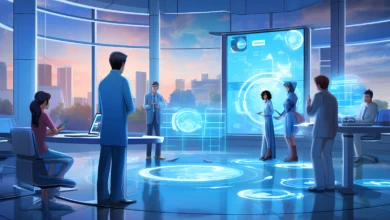Computer Simulation Technology: Unlocking the Future of Virtual Modeling

Introduction to Computer Simulation Technology
Imagine a world where complex problems can be solved without ever stepping into the real environment. This is not science fiction; it’s the power of computer simulation technology. As our reliance on digital solutions grows, this cutting-edge approach to virtual modeling is transforming industries across the globe. From predicting weather patterns to designing intricate aircraft systems, computer simulations allow us to visualize scenarios and outcomes safely and efficiently.
What if you could run experiments that would take years or even decades in mere seconds? With computer simulation technology, that’s exactly what we can do. It offers an exciting glimpse into possibilities once thought impossible—enabling innovation at an unprecedented pace. Dive deeper with us as we explore how this fascinating technology works, its diverse applications, and what lies ahead for the future of virtual modeling.
How It Works: The Basics of Virtual Modeling
Virtual modeling operates on the principles of computer simulation technology. It translates real-world scenarios into digital environments, allowing users to manipulate variables and observe outcomes.
At its core, this technology uses mathematical models. These models represent physical systems or processes in a virtual space. By entering data related to various elements, users can visualize complex interactions without any risk.
The simulations run algorithms that predict potential results based on input parameters. This predictive capability helps in testing hypotheses efficiently.
Additionally, advanced graphics render these models visually appealing and easy to understand. Users can interact with the model dynamically, providing insights that static images cannot offer.
This combination of mathematics and visual representation transforms how industries approach problem-solving and design processes across various fields.
Applications and Benefits of Computer Simulation Technology
Computer Simulation Technology is revolutionizing various industries. In manufacturing, it streamlines processes and reduces costs by allowing virtual testing of products before they are made. This minimizes waste and enhances efficiency.
In healthcare, simulations aid in training medical professionals. They can practice complex procedures without risks to real patients. This hands-on experience improves skills and boosts confidence.
The automotive industry benefits significantly as well. Engineers use simulations to design safer vehicles while optimizing performance features like fuel efficiency.
Moreover, urban planners employ computer simulation technology for modeling traffic patterns or environmental impacts. These insights lead to better decision-making for sustainable development.
Education also sees enhancements through interactive learning environments powered by simulation technology. Students grasp difficult concepts more easily when they visualize them in action, making education engaging and effective.
Case Studies: Real-Life Examples of Successful Virtual Modeling
One notable case study in computer simulation technology comes from the automotive industry. A leading car manufacturer used virtual modeling to design a new electric vehicle. By simulating aerodynamics and thermal dynamics, they optimized performance while reducing prototype costs. The result was a sleek design that performed better than anticipated.
In healthcare, researchers employed virtual modeling for surgical training. They created lifelike simulations for complex procedures, allowing surgeons to practice without risk. This innovative approach improved skill levels and boosted confidence before operating on real patients.
The aerospace sector also benefits significantly from virtual modeling. An aircraft designer utilized computer simulations to test materials under extreme conditions before actual production began. This not only saved time but also ensured safety standards were met well ahead of flight tests.
These examples illustrate the versatility of computer simulation technology across various fields, showcasing how it drives innovation and efficiency through realistic virtual environments.
Limitations and Challenges of Computer Simulation Technology
Computer Simulation Technology, while revolutionary, is not without its hurdles. One significant challenge lies in the accuracy of models. Simulations depend heavily on data inputs and assumptions. If these are flawed or incomplete, results can lead to misleading conclusions.
Another concern is computational power. Complex simulations require substantial processing resources. This need can limit accessibility for smaller organizations or individual researchers.
Additionally, interpreting simulation outcomes poses difficulties. Users may misinterpret data due to a lack of expertise or understanding of underlying principles.
Ethical considerations emerge as technology advances. As virtual modeling becomes more integrated into decision-making processes, questions about accountability and transparency arise. The balance between innovation and responsibility remains a delicate dance in this evolving field.
The Future of Virtual Modeling: Predictions and Innovations
The landscape of virtual modeling is evolving rapidly. Emerging technologies like artificial intelligence and machine learning are set to enhance the capabilities of computer simulation technology.
Imagine simulations that adapt in real-time based on user interactions or environmental changes. This level of responsiveness could revolutionize industries, from healthcare to urban planning.
Moreover, advancements in virtual reality (VR) and augmented reality (AR) will likely create more immersive experiences. Users may find themselves stepping into their models rather than just observing them.
Collaboration tools integrated into these platforms can foster teamwork across vast distances. Teams will be able to manipulate complex models together as if they were in the same room.
As we move forward, sustainability will also play a crucial role. Simulations could help predict ecological impacts before projects even begin, paving the way for greener solutions globally.
Conclusion
Computer Simulation Technology is reshaping how industries approach problem-solving and innovation. By providing a platform for virtual modeling, it allows professionals to visualize complex systems, test scenarios, and predict outcomes without the constraints of physical limitations.
As we move forward into an era where digital transformation continues to accelerate, the potential for Computer Simulation Technology is immense. Innovations are on the horizon that promise even more sophisticated simulations with enhanced accuracy. The integration of artificial intelligence and machine learning will likely push these boundaries further, making virtual modeling even more intuitive and powerful.
The ongoing development in this field signifies not just a trend but a fundamental shift in how we understand and interact with technology. Whether in engineering, healthcare, or environmental science, embracing Computer Simulation Technology means stepping into a future filled with possibilities that were once confined to imagination alone. As industries adopt these tools more widely, they open doors to solutions previously deemed unattainable—a true testament to what lies ahead when creativity meets technology.
Explore the impact of technology on personal networks in our Mega Personal Net Technology article.



